Vegetable platters have a reputation for being bland and flavorless. How often have you seen the vegetable platter get passed over for more appealing appetizers at a party? Not anymore! These veggie tray ideas will take the boring vegetable platter to new heights with unique flavors, textures, and dips to tantalize your tastebuds!
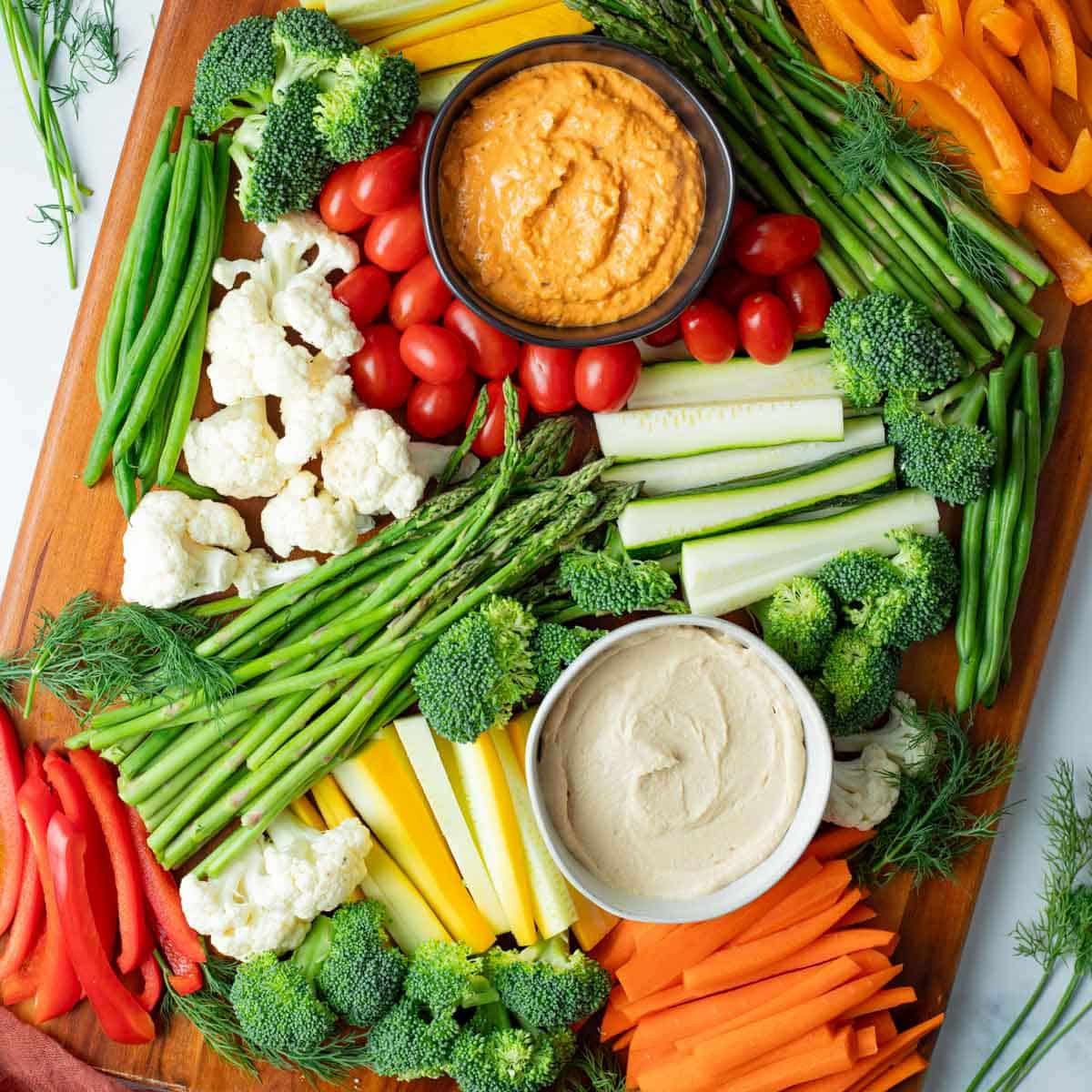
Jump to:
- 💗 Why You’ll Love These Veggie Tray Ideas
- 🥣 Best Vegetables to Use for a Veggie Tray
- 🥣 Best Dips for Veggie Trays
- 🥒 Tips for Preparing Veggies
- 🥦 How to Arrange Veggies on a Veggie Tray
- 👩🏻🍳 How To Make A Veggie Tray
- ❓ Veggie Tray Ideas FAQS
- 📝 Expert Tips
- 🍽 How to Serve
- 🫙 How to Store and Keep
- ⚖️ Serving Size
- 😋 More Party Appetizers!
- Recipe
If you are one of those people who do not know what to include on their veggie platter, brace yourself because you are about to discover many veggie tray ideas you will find super helpful! I include vegetables in my meals daily, so I always try to find ways to combine them creatively. I believe a tray with vegetables can be more delicious and appealing with unique combinations you might haven’t thought of yet. Plus, it is an effective way to encourage yourself to eat more veggies throughout the week! It also makes for an impressive appetizer at any celebration or cocktail party.
Are you looking for more veggie tray ideas? Try these unique trays for the holidays!
💗 Why You’ll Love These Veggie Tray Ideas
- Practically no cooking time.
- Incredibly easy to prepare.
- Many vitamins will be consumed through combinations of different kinds of vegetables.
- Never enough dips! So more varieties of dip sauces with veggies.
- It is truly a healthy snack for any time of the day.
🥣 Best Vegetables to Use for a Veggie Tray
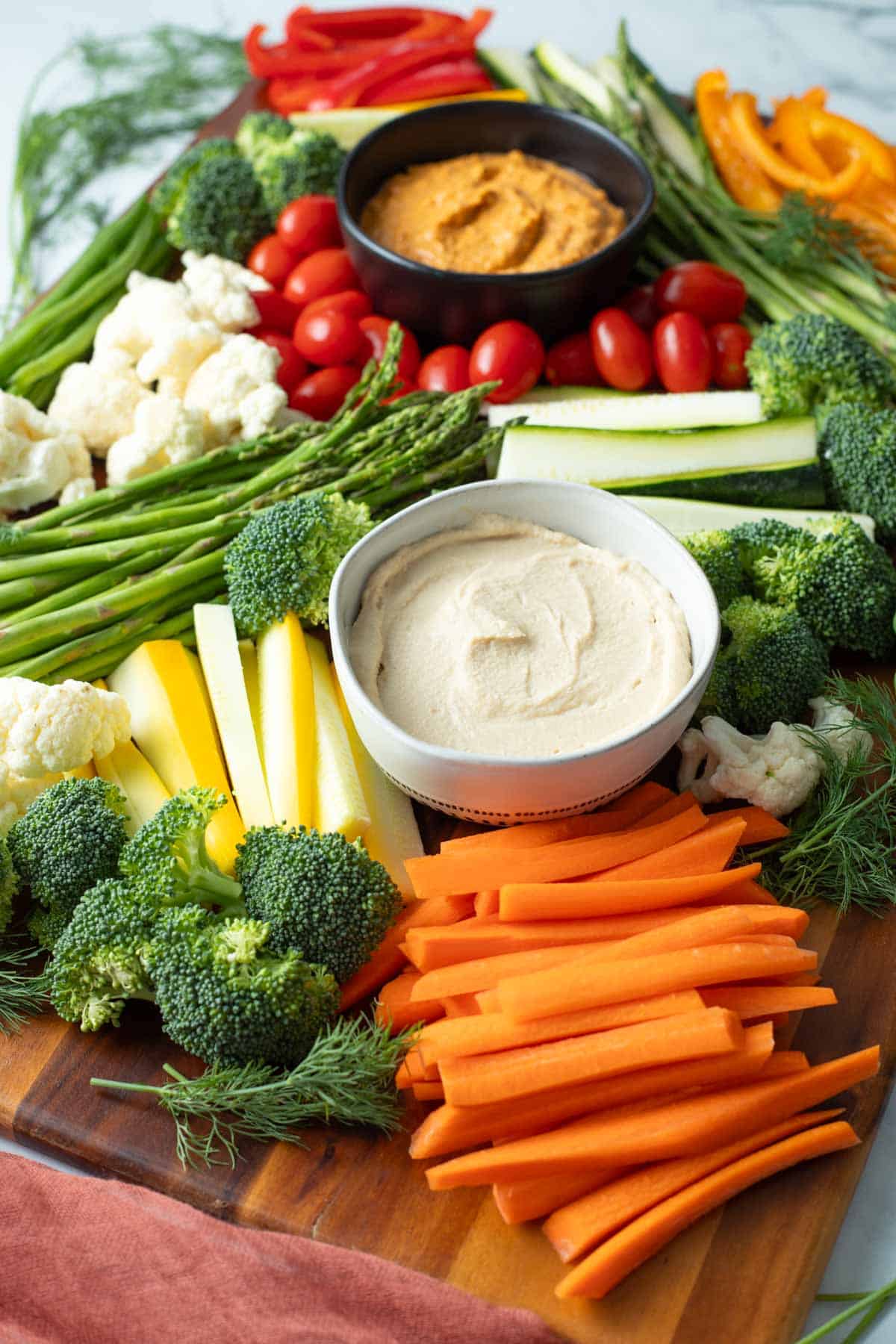
Raw Vegetables
- Carrots – I try to include carrots in every veggie tray because they are incredibly rich in vitamin A, fiber, and beta-carotene. You can opt for baby carrots, rainbow carrots, or orange carrot sticks.
- Bell Peppers (green, red, orange, yellow) – I combine all kinds of bell peppers, but if you like the bitter taste, opt for the green ones. And if you don’t, red, orange, and yellow pepper are all great!
- Celery – If I can include celery in my vegetable tray, I will do it in a heartbeat! Celery is practically a fountain of youth, it has so many vitamins and minerals.
- Cucumber – Got to keep ourselves hydrated, and there’s no better way to do so than with cucumbers! It has a high water content that will refresh your body.
- Radishes – I love using radishes to add spiciness to my vegetable tray. They are peppery and perfect for adding unique flavor to dishes.
- Cherry Tomatoes – Since it is a veggie platter, I tend to use more petite tomatoes like the cherries, but you can always go with tomatoes if you are not a fan of this alternative. Chop them, slice them, keep them whole – whatever you prefer.
- Jicama – I always add crunchiness to my vegetable platter, so this is the perfect ingredient.
- Broccoli Florets – I go with fresh broccoli florets, but if you do not like them fresh, you can opt for their steamed version.
- Cauliflower Florets – I love some nutty taste in my veggie tray, and adding fresh cauliflower florets will do the trick.
- Sugar Snap Peas – A great healthy snack that I like to include in my salads and veggie trays because it adds a subtle sweet taste to the vegetables. It achieves the perfect harmonious balance.
Blanched Vegetables
- Asparagus – This superfood tends to reach almost all of my veggie trays. Still, if you don’t like their taste, you can also go with Brussels sprouts. Or maybe green beans? They have quite a similar taste.
- Yellow Squash – A great sweet addition to a veggie tray! Not a fan? You can always replace it with butternut or pattypan squash.
- Zucchini – high water content and a lovely flavor. What’s not to love? But if you don’t like the taste of zucchini, opt for sweet potatoes or eggplant.
🥣 Best Dips for Veggie Trays

- Vegan Chipotle Sauce – You only need 5 minutes and five ingredients to prepare your dip sauce. It goes great with many vegetables and is a perfect addition to veggie platters.
- Vegan Avocado Dressing – Avocado dressing makes a perfect dip sauce for a vegetable tray because it is simple and healthy. You only need to mix six ingredients, and your dressing will be ready in 5 minutes.
- Vegan Tahini Dressing – This dressing requires only tahini, garlic, and lemon in the mix, and you will obtain the perfect dip for your veggies.
- Hummus: Make your fresh hummus or buy your favorite brand from the store. It’s a great option as it’s high in protein and allergy friendly.
🥒 Tips for Preparing Veggies
- Variety: Include diverse vegetables with different colors, textures, and flavors. This makes the tray look attractive and offers a range of tastes for your guests.
- Use Fresh Vegetables: Choose the freshest vegetables available. Look for vibrant colors, crisp textures, and avoid any signs of wilting or discoloration.
- Wash: Thoroughly clean all the vegetables before preparing them. Wash them under cold running water to remove any dirt or pesticides. Pat them dry with paper towels to avoid excess moisture on the tray.
- Bite-Sized Pieces: Chop or slice them into bite-sized pieces, making them easy to pick up and eat. Uniform cuts give the tray a neat and organized appearance.
- Edible Garnishes: Add edible garnishes like fresh herbs (e.g., parsley, cilantro) or edible flowers to add an extra touch of color and elegance to the tray.
- Variety of Dips: Veggie trays often pair well with a tasty dip. Standard options include hummus, ranch dressing, tzatziki, or a spinach-artichoke dip. Place the dip in the center of the tray in a separate bowl. Use more than one dip.
- Arrange Attractively: Presentation matters, so arrange the veggies on the tray appealingly. You can organize them by color or create patterns to make the tray visually appealing.
- Use More Than One Platter: Consider using different shapes and sizes of trays or platters to add visual interest to your presentation. Mixing and matching can create a unique and inviting display.
- Season: For some vegetables, a light sprinkle of salt and pepper can enhance the flavors. However, keeping the seasoning minimal is best, as the dip adds flavor.
- Keep it Cool: If you’re not serving the veggies immediately, cover the tray with plastic wrap or store it in the refrigerator to keep them fresh and crisp until your guests arrive.
🥦 How to Arrange Veggies on a Veggie Tray
Start with a clean platter: Use a large, clean, and preferably white or neutral-colored platter as your canvas. This will allow the colors of the vegetables to stand out.
Select a central dip container: Place a bowl or small container of your dip in the center of the platter. It will act as the focal point and anchor for the arrangement. Or, if you have more than one dip, arrange one on either side of the platter.
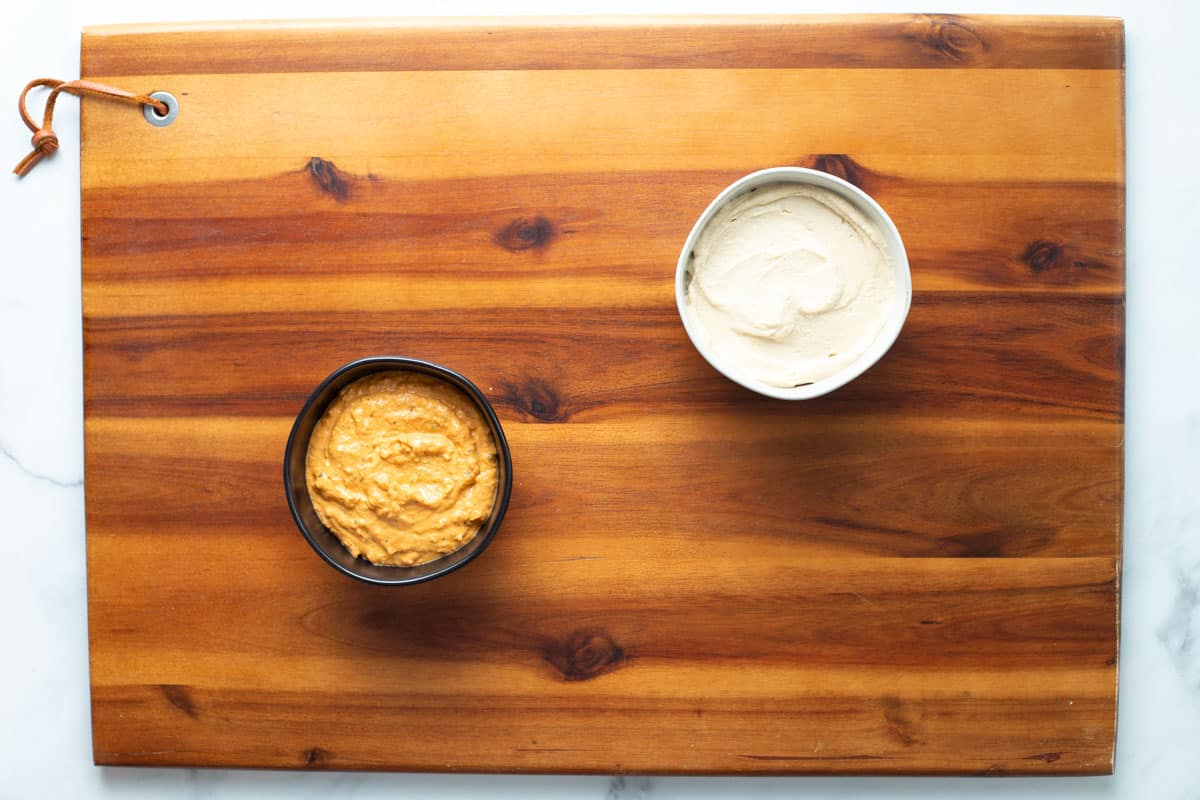
Group vegetables by type: Organize them into groups based on their type and color. For example, group all the colorful bell peppers together, all the greens (cucumber, celery), and so on.
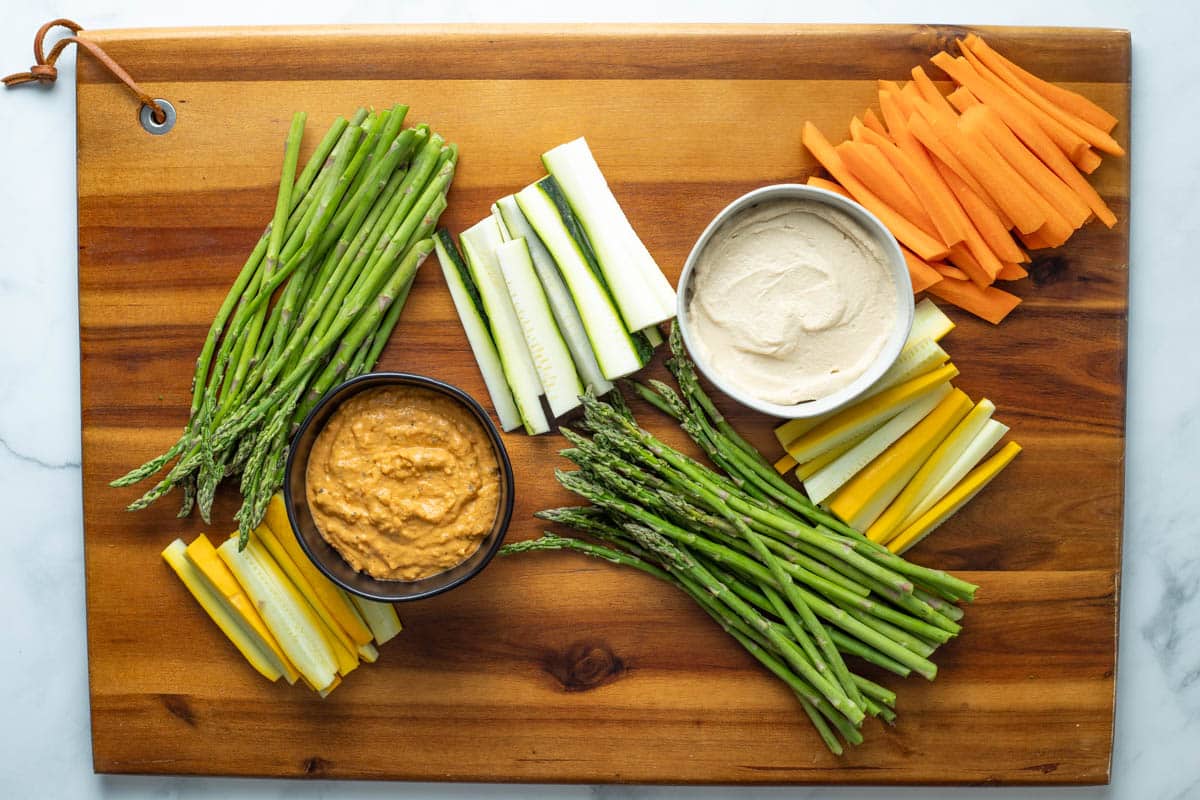
Create balance and symmetry: Aim for a symmetrical arrangement around the dip bowl. Symmetry is visually pleasing and makes it easier for guests to access the veggies from all sides.
Larger vegetables towards the edge: Arrange the larger and taller vegetables around the edges of the platter. These include carrot sticks, celery stalks, broccoli florets, and cauliflower.
Add color and variety: Fill the spaces between the larger vegetables with smaller and more colorful options like cherry tomatoes, sliced radishes, and snap peas.
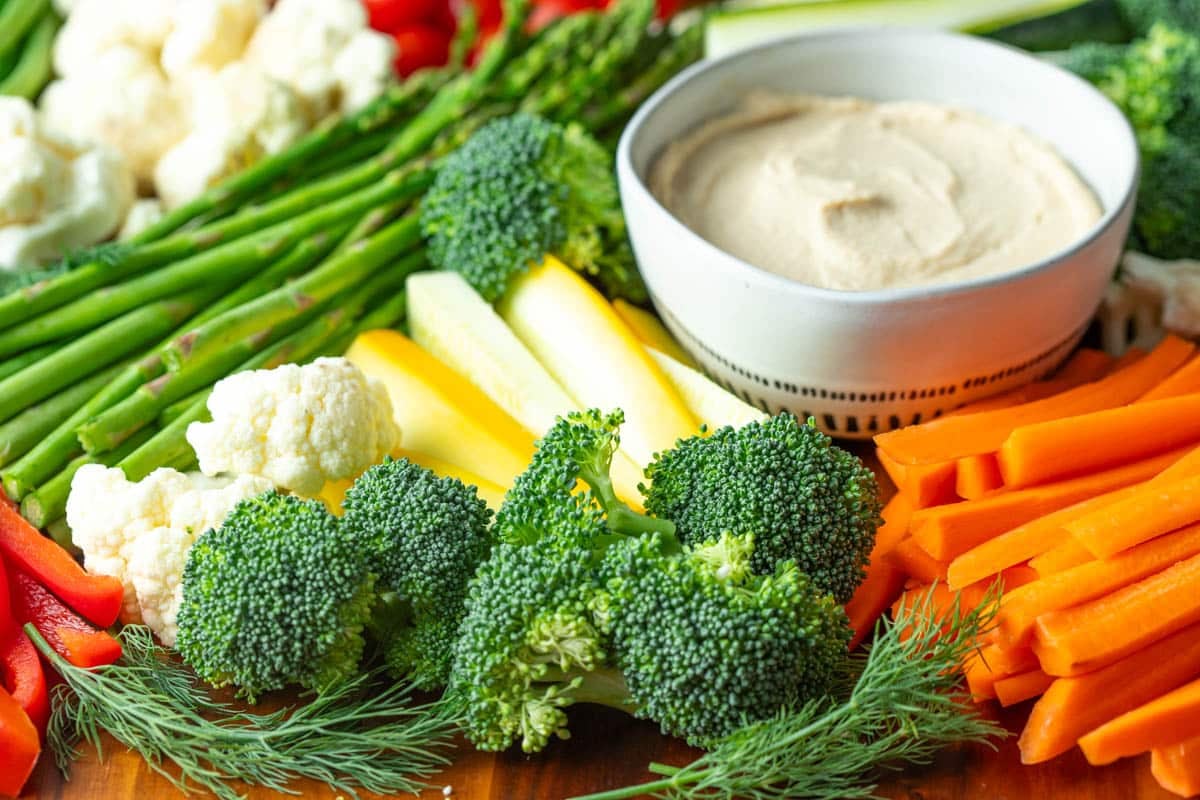
Consider the visual flow: Create a visually appealing flow by arranging the vegetables in a circular or curved pattern, radiating outward from the dip bowl. This helps guide the eyes around the platter.
Use garnishes: Add some edible garnishes, such as fresh herbs or edible flowers, in empty spaces or around the edges of the platter to add a pop of color and elegance.
Keep it neat: Make sure the vegetables are neatly arranged and not overcrowded. Leave enough space between different vegetables to allow easy grabbing with fingers or tongs.
Replenish as needed: If the party or gathering will last for an extended period, be prepared to replenish the veggies as they are consumed to keep the platter looking fresh.
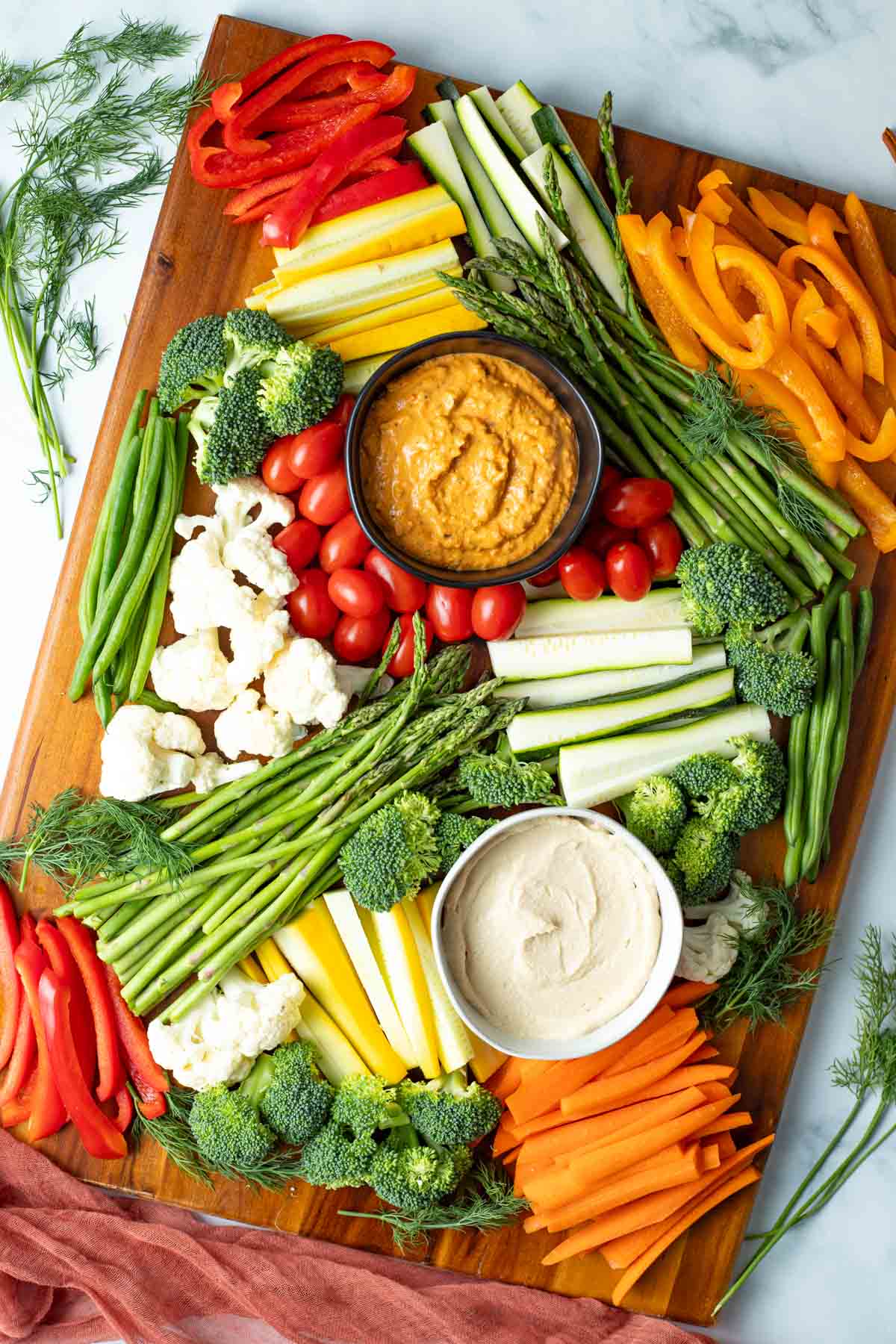
👩🏻🍳 How To Make A Veggie Tray
- Prepare Raw Vegetables: Wash thoroughly and dry all the raw vegetables. Then cut them into slices.
- Prepare Blanched Vegetables: Add the trimmed and cut vegetables to a large pot of boiling water. Allow them to boil for 1 minute. Then quickly transfer them to an ice bath. Allow them to cool in the ice bath for 3 minutes. Then drain and pat dry.
- Place the vegetables on a large platter with the dipping sauce in the center: Place two dipping sauces on either side of the large platter to create balance. When arranging the vegetables, consider alternating colors and shapes around the platter. This creates visual interest in the vegetable tray.
❓ Veggie Tray Ideas FAQS
Placing a bowl of ice below your vegetable platter is always a good idea to keep your veggies fresh. Another option is to place a damp paper towel beneath the tray. However, to secure the freshness of your veggies when you do not eat them, you can use a lid or plastic wrapping paper to cover them.
You can use different kinds of vegetables in your veggie platter ideas. Some can stay fresh longer, while others might not have the same ability. You can prepare your platter a few hours before serving, but it is best to do so as close to serving time.
Using as many vegetables as possible on your veggie platter is always recommended. However, you can always customize it to your preferences as long as you include a variety of vegetables with different colors, textures, and flavors.
Yes, crudité and veggie trays generally refer to the same appetizer. The term “crudité is French and refers to a selection of raw vegetables served as appetizers. It typically includes a variety of fresh, sliced, or whole vegetables such as carrots, celery, cucumbers, bell peppers, cherry tomatoes, broccoli, cauliflower, radishes, and more. Like a vegetable platter it is served with a dip, such as hummus, ranch dressing, tzatziki, or aioli, to complement the flavors of the vegetables.
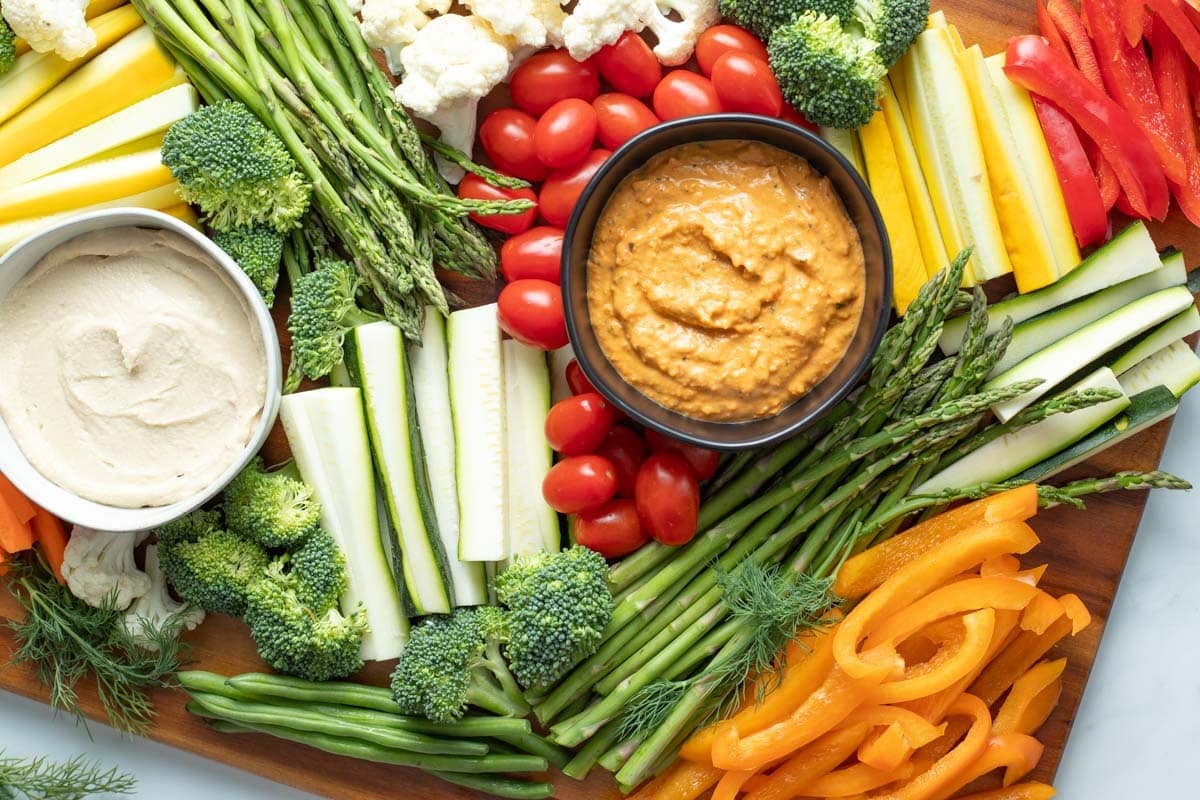
📝 Expert Tips
- Veggie trays require colorfulness, so arrange your vegetables in matching hues for a better visual effect.
- Prepare your tray half an hour before serving because freshness is key.
- Add one dipping sauce for small trays and 2-3 dips for large trays.
- Complement your veggie platter with some cheese and nuts.
🍽 How to Serve
The way you serve your veggie platter is as important as the vegetables you include in it:
- Choose a big attractive platter.
- Arrange your vegetables in colors and shapes.
- Put the dip sauces in the center of your tray.
🫙 How to Store and Keep
The best way to store and keep your vegetable tray is by covering it with a plastic wrap or lid. Didn’t you finish your tray? Then cover and store it in the fridge to ensure your veggies stay fresh. This will allow them to stay fresh for a few days at least. Remember also to cover the dip sauces and keep them fresh!
I hope you enjoyed my veggie tray ideas and will try them at home. For more food tips, check out my blog page.
⚖️ Serving Size
Depending on how many vegetables you choose to use and the size of the platter, you could serve anywhere from 6-20 people.
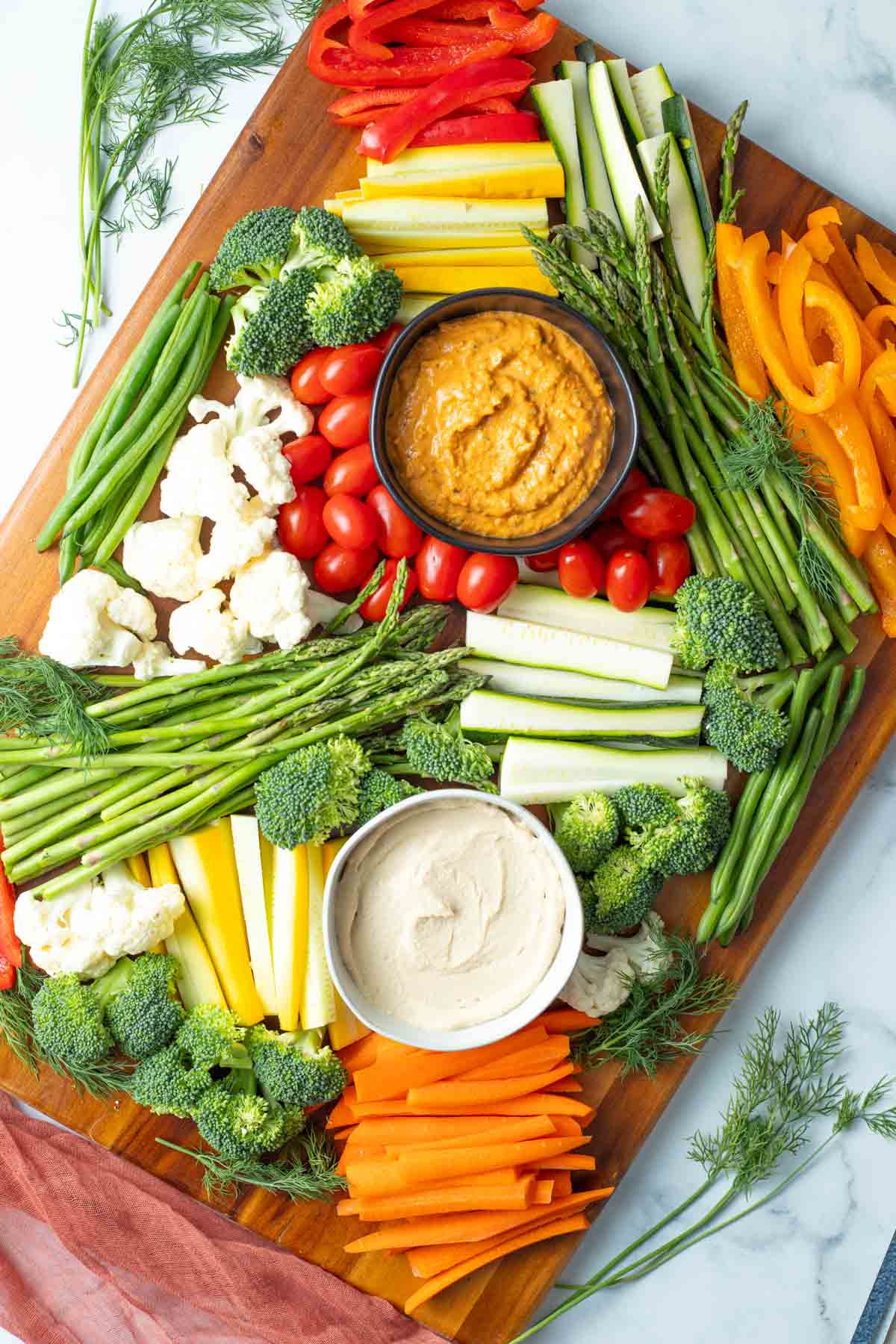
😋 More Party Appetizers!
Recipe
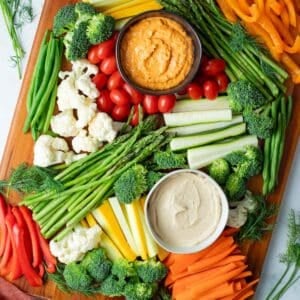
Veggie Tray Ideas
Equipment
Ingredients
Raw Vegetables
- 3 large carrots
- 2 bell peppers red, orange, yellow
- 4 stalks celery
- 1 English cucumber
- 1 cup radishes
- 1 pint cherry tomatoes
- 1 cup jicama
- 1 cup broccoli florets
- 1 cup cauliflower florets
- 1 cup sugar snap peas
Blanched Vegetables
- 1 bunch asparagus
- 1 yellow squash
- 1 zucchini
- 1 cup green beans
Dips
- hummus
- ranch dressing
- chipotle dip
- tzatziki
Instructions
- Select Vegetables: Choose a combination of raw and blanched vegetables for your veggie tray. When considering which vegetables to use, choose a variety of textures and colors. I recommend choosing 3-5 raw vegetables and 2-3 blanched vegetables.
- Choose Your Dipping Sauces: For a small veggie tray choose one dipping sauce, for a larger veggie tray. Choose 2-3 dipping sauces. Place them in small bowls, and arrange them in the cinter of the tray.
- Prepare Raw Vegetables: Wash thoroughly and dry all the raw vegetables. Then cut them into slices.
- Prepare Blanched Vegetables: Add the trimmed and cut vegetables to a large pot of boiling water. Allow them to boil for 1 minute. Then quickly transfer them to an ice bath. Allow them to cool in the ice bath for 3 minutes. Then drain and pat dry.
- Place the vegetables on a large platter with the dipping sauce in the center: Place two dipping sauces on either side of the large platter to create balance. When arranging the vegetables, consider alternating colors and shapes around the platter. This creates visual interest in the vegetable tray.
Notes
-
- Veggie trays require colorfulness, so arrange your vegetables in matching hues for a better visual effect.
- Prepare your tray half an hour before serving because freshness is key.
- Add one dipping sauce for small trays and 2-3 dips for large trays.
- Complement your veggie platter with some cheese and nuts.
- Choose a big attractive platter.
- Arrange your vegetables in colors and shapes.
- Put the dip sauces in the center of your tray.
- Add some edible garnishes, such as fresh herbs or edible flowers, in empty spaces or around the edges of the platter to add a pop of color and elegance.



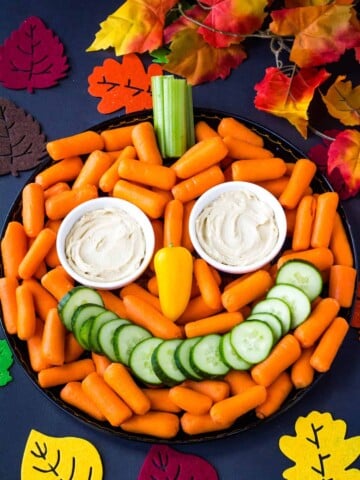
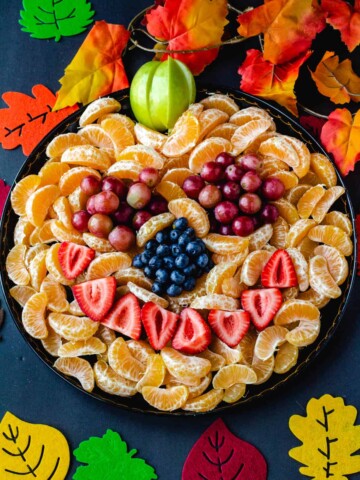
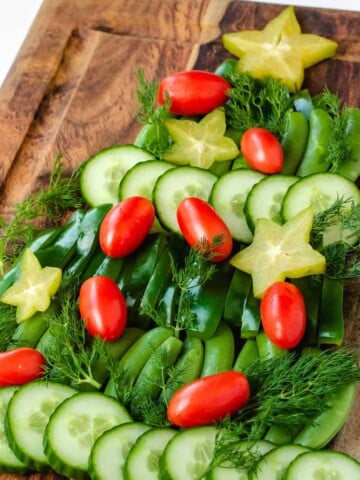
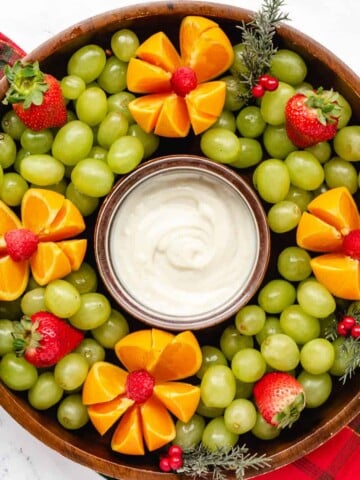
Tracy
So many great ideas! You make veggies look the most appetizing that your tips helped us get the kiddos to eat them too!
Andrea
I love your presentation and dips for these fabulous vegetables. It’s very appealing and I believe there will be no leftovers.
Ali
Love the presentation for these trays!! I can never make mine look this pretty, going to copy your for my next gathering!
Carrie Robinson
I fresh veggie tray is perfect for summertime entertaining! 🙂 And such a great way to use up those garden/farmers market veggies too.